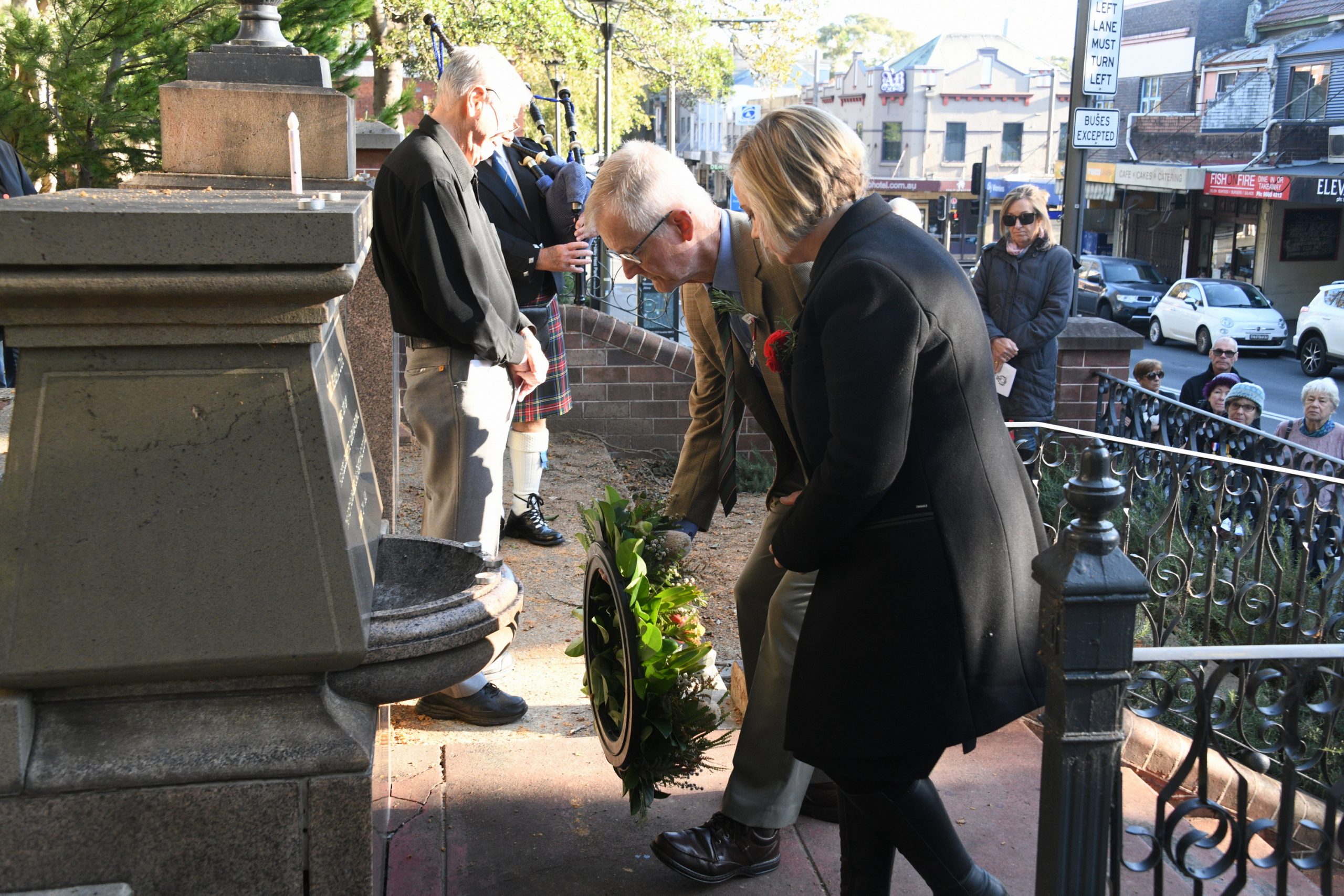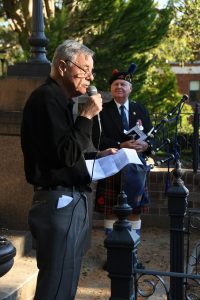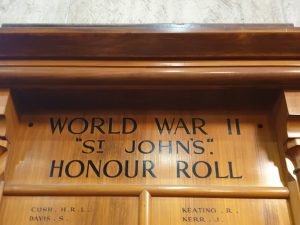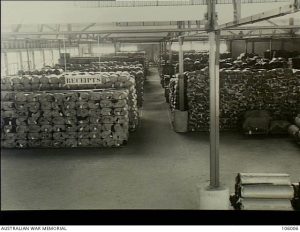
April 2021, from Bulletin 2 of 2021
About 50 people attended the service at the Glebe Diggers Memorial in Foley Park on Anzac Day. The service was led by Rev Mark Wormell, rector of St John’s, and the piper was Rob McLean.
After the service, attendees enjoyed a delectable morning tea in the grounds of St Johns Church – thank you to Lyn Milton and Jude Paul for organising it. Thanks also to Phil Young for lugging the PA to and from the service.
A special thanks to Max Solling who, as every year, arranged the event and provided the address.
Anzac Day address, by Max Solling
This morning I’d like to share some thoughts about the impact of the Second World War on Glebe residents. As the country emerged from the economic hardship of the Depression, Australians watched for war approaching in 1939 and the dominant passion was not bellicose excitement but rather regret tinged with disappointment that war must come again. War disrupted and constricted living patterns; for half a decade normal life was suspended.

The Second World War was a truly global war in human life of at least 60 million. Russia suffered the greatest number of casualties, 27 million. of whom 18 million were civilians. War devastated Europe, triggered massive movements in populations, unleashed irresistible forces of nationalism in Asia, leaving the international order irrevocably changed.
Despite its scale it resulted in fewer casualties for Australia than in the First World War. The total death toll on active service was 39,000 (out of a population of 7 million), in contrast with about 60,000 from a population of 5 million. Australia’s economy and society was mobilised to an unprecedented degree, with 550,000 men and women serving overseas in the armed services.
Australia raised four volunteer infantry divisions, three of which (6th, 7th and 9th) were committed in the first two years to the Middle East and Mediterranean theatres. The RAN served with its British counterparts in most oceans, and Australia sent 26,000 airmen to serve with the RAF through the Empire Air Training Scheme.
The attack on Pearl Harbour on 7 December 1941 signalled Japan’s entry into the war, and a campaign which saw Malaya, Singapore, Burma and the Dutch East Indies captured by the Japanese by March 1942. The fall of Singapore was a catastrophe and the fate of thousands imprisoned by the Japanese was difficult to interpret, and showed the sun was setting on the British Empire.
The 6th and 7th Divisions were recalled from the Middle East in response to the crisis when the 8th Division went into captivity and the Allied troops were taken prisoner.
American General Douglas Macarthur arrived in Australia in March 1942 as commander of the South West Pacific forces. The strategy of Australian forces was to hold the Japanese attacks on Papua and New Guinea with gruelling campaigns on the north coast.
Having failed a seaborne attempt to take Port Moresby, Japanese troops landed on the north coast, with the aim of crossing the Owen Stanley ranges by land. The terrain was dense rainforest, and a track winding up and down precipitous ridges, with malarial swamplands. Australian troops advanced north from Port Moresby along this track to the airstrip at Kokoda. The Australians launched a counter attack with the extraordinary support of indigenous stretcher bearers, and retook Kokoda on 2 November 1942. The heroism of Australian and Papuan soldiers became one of the key images of the Pacific war. Australians and Americans then drove the Japanese from their fortified beachheads at Buna, Gona and Sanananda. By the end of 1942 the Japanese advance had ended, and after the Battle of Stalingrad the tide in Europe had turned against Germany.

Names of Glebe residents who enlisted in the First World War are recorded in the foyer of its town hall. But nowhere in the local landscape is there a record of those who enlisted between 1939 and 1945, with one exception: 142 parishioners on St Johns Bishopthorpe honour roll. 2,347 Glebe men and 79 Glebe women, 2,426 altogether, enlisted, of which 80% were in the AIF, and 16% in the RAAF.
A strong collective memory of troop trains, that travelled along the goods line that passed by tunnel under Glebe, remains. Families and friends gathered near the tunnel mouth to farewell the soldiers, displaying placards with the names and number of enlisted locals. And at Foley Park slit trenches were dug and American troops occupied Wentworth Park from 1943.
On the southern side of the harbour ties of work, residence, recreation and kinship in municipalities encircling the Sydney CBD made for a close working class culture whose values and attitudes embodied a way of life which embraced reciprocity, neighbourliness, and mutual aid of a monetary and non-monetary kind, with Glebe controlled by a Labor Council from 1925 to 1939 and 1941 to 1948.
Glebe was a constituent part of industrialised inner Sydney with 156 factories employing 4,496 people. A predominantly tenanted community, its population of 20,510 at the 1947 census was overwhelmingly Australian-born ‒ 89% men and 92% women and the largest source of employment for Glebe’s workforce was manufacturing.

In a society where the adult male of the household was regarded as the breadwinner, only 28% of Glebe’s women were in paid employment; the balance, 72% of local women not in paid work, managed the family budget, displaying frugality and ingenuity in making ends meet, and during the war they were actively recruited into jobs that had always been the preserve of men. Local women raised large families in a rented terrace on a single wage.
Glebe continued to be a largely pedestrian society, shaped and fed upon clusters of shops along its main streets ‒ 13 butchers, 39 mixed businesses, 29 grocers, 20 fruiterers, 16 bootmakers, 19 hairdressers, 3 bakeries and 5 milk bars, and Glebe’s beer trade at its 16 pubs was frenetic in the hour or so before six o’clock closing.
Working a 40-hour week, a Saturday evening at the Astor Picture Theatre was sort of nirvana while there was ample opportunity for a little flutter, only a short walk or tram ride away at the trots on Friday night and the dogs on Saturday night.
Prime Minister John Curtin decided, as in the last war, no remains of Australia’s war dead were to be brought home. And a 1944 Gallup poll asked a sample population, ‘What kind of war memorial do you favour?’ Utility demonstrably triumphed: 90% voted for functional memorials ‒ hospitals, schools, halls, parks, swimming pools, they said, or ‘anything useful’. In some cities and towns names of those who enlisted and died were added to old memorials. The youngest from Glebe to enlist were 17-year-old Neville Frost (Merchant Navy) and three 18-year-olds, Gloria Newlyn (RAAF), Desmond McLean (AIF) and Nurtheen Darke (RAN).
Over 30,000 Australians were taken prisoner during the war. Eight thousand in Italy and Germany of whom 265 died, and 22,000 in Japan and its occupied territories, of whom 8,200 died. Of the 22,000 prisoners held by the Japanese, one third died in captivity, representing one quarter of all Australians combat deaths in the war.
Australians witnessed the return of 14,000 survivors of Japanese imprisonment in late 1945 and this image has remained vivid. The prisoners of war had suffered considerable privations, not the terrifying annihilation of combat but the insidious bodily decay wrought by torture, starvation and disease.
Edward ‘Weary’ Dunlop, born in 1907, an Australian surgeon renowned for his compassionate medical care and leadership while prisoner of the Japanese, believed his 1942-1945 diaries should remain unpublished for 40 years, for fear that they might add further to the suffering of the bereaved. But in 1986, in the evening of his life, he was able to put things in perspective. Dunlop was both chief physician and commanding officer of 1,000 men forced to work on construction of the Burma-Thailand railway ‒ 415 kilometres from Ban Pong to Burma. He displayed both compassion and courage in caring for and protecting his men. On a number of occasions he put his own life on the line by standing up to the captors to defend his fellow POWs against cruelty and brutality. Overall 12,000 POWs died on the railway including 2,700 Australians.
Dunlop wrote in the preface to the published version of his diaries: ‘Those in the medical services had the stimulus of the stark needs of a deluge of piteously ill men, and most doctors were fearless in approaches to our captors. However much of the salvage of sick and broken men was achieved by securing the involvement of the whole stricken force in the sharing of slender resources, money and food and contributing ingenious improvisations and gifts of labours of love out of their ebbing energy’. After he died on 2 July 1993, Dunlop’s ashes were taken back to the Burma-Thailand railway at dawn on Anzac Day 1994 at a place prisoners called Hellfire Pass. Collective bonding was fundamental to the prisoner-of war-story. Tom Uren (1921-2015), left school at 13, and in his words, became a pick and shovel worker, boxer, and member of the AIF in Timor in 1942 where, as a 20-year-old he became a prisoner of war of the Japanese and was sent to work on the Burma-Thailand railway. In reminiscences he gave in 1996 Tom recalled: ‘‘Weary’ Dunlop really was a remarkable man. I always called him Colonel. Under the Geneva Convention they had paid the officers and medical orderlies an allowance of money, and the men who went out to work were paid a small wage.
Tom continued, ‘Weary would pool the great bulk of that wealth into a central fund and with the money from that we would go out and get people to trade with Thai and Chinese traders and get medical supplies and food to look after our sick and our needy. In the camp the strong looked after the sick, collectivising our wealth. And it was that great collective spirit, working together under Weary. I’ve got happy memories of Weary, and he still remains with me.’ Uren found the camp experience the fire in which the legacy of his mother’s instinctive hatred of social exploitation was tempered into a life-long belief in the principles of socialism.
Fellow prisoner and Glebe rower Stan Arneil also kept a diary of his entire imprisonment as a prisoner of war, and published it as ‘One Man’s War’ in 1980. ‘It was the greatest privilege of my life’, he wrote ‘to have been part of that group’.










There are no comments yet. Please leave yours.